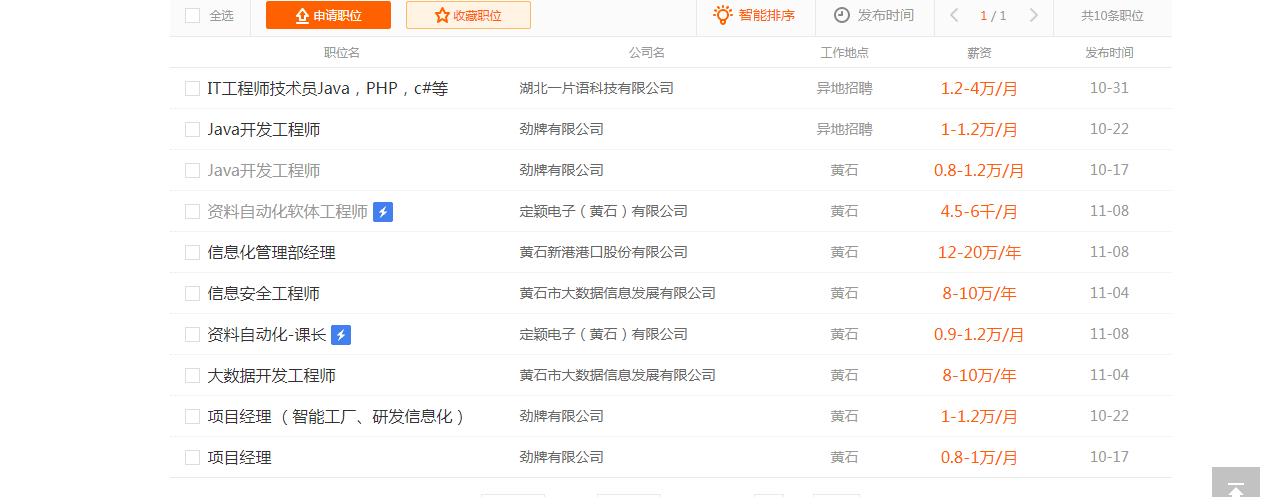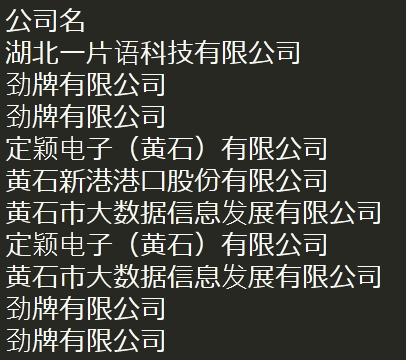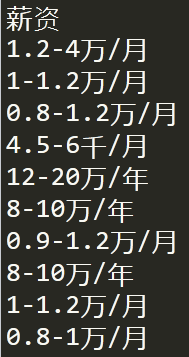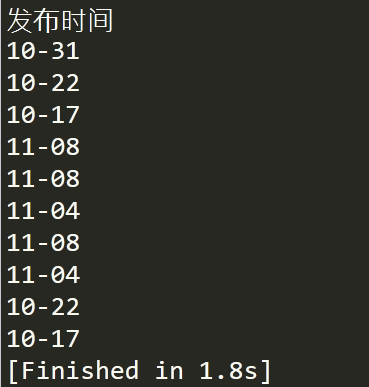一、用python爬取一个求职网页的一些信息
网页截图如下:

代码:
import requests from bs4 import BeautifulSoup import io import sys sys.stdout=io.TextIOWrapper(sys.stdout.buffer,encoding='gb18030') headers={ "User-Agent": "Mozilla/5.0 (Windows NT 10.0; Win64; x64) AppleWebKit/537.36 (KHTML, like Gecko) Chrome/70.0.3538.110 Safari/537.36"} r=requests.get('https://search.51job.com/list/180400,000000,0000,00,9,99,java,2,1.html?lang=c&stype=1&postchannel=0000&workyear=99&cotype=99°reefrom=99&jobterm=99&companysize=99&lonlat=0%2C0&radius=-1&ord_field=0&confirmdate=9&fromType=&dibiaoid=0&address=&line=&specialarea=00&from=&welfare=') r.encoding=r.apparent_encoding result=r.text bs=BeautifulSoup(result,'html.parser') li=bs.find_all('p',attrs={'class':'t1'}) for l in li: print(l.text) li1=bs.find_all('span',attrs={'class':'t2'}) for m in li1: print(m.text) li2=bs.find_all('span',attrs={'class':'t3'}) for n in li2: print(n.text) li3=bs.find_all('span',attrs={'class':'t4'}) for a in li3: print(a.text) li4=bs.find_all('span',attrs={'class':'t5'}) for b in li4: print(b.text)
结果:





二、python代码
算24
描述
给出4个小于10的正整数,可以使用加、减、乘、除4种运算以及括号把4个数连接起来得到一个表达式。现在问题是,是否存在一种方式使得所得表达式的结果等于24。
这里加、减、乘、除以及括号的运算结果和运算优先级跟平常定义一致。
例如,对于5,5,5,1,可知5×(5-1/5)=24。又如,对于1,1,4,2无论如何都不能得到24。
1.
from itertools import permutations n1 = input("") n2 = input("") n3 = input("") n4 = input("") n = n1+n2+n3+n4 sum = 1 for i in n: sum *= eval(i) if sum < 24: print("NO") exit() notation = ['+', '-', '*', "/"] st = set() num = 0 number = set(permutations(n)) for i in notation: s = i t1 = notation.copy() t1.remove(i) for j in t1: s += j t2 = t1.copy() t2.remove(j) for p in t2: s += p st.add(s) s = i+j s = i newst = set() for i in number: for j in st: newst.add(i[0]+j[0]+i[1]+j[1]+i[2]+j[2]+i[3]) # print(newst) all = set() for i in newst: i1 = '('+i[0:3]+')'+i[3:] i2 = i[0:2]+'('+i[2:5]+')'+i[5:] i3 = i[0:4] + '(' + i[4:] + ')' i4 = '(('+i[0:3]+')'+i[3:5]+")"+i[5:] i5 = i[0:2]+'(('+i[2:5]+')'+i[5:]+")" i6 = '(' + i[0:2] + '(' + i[2:5] + '))' + i[5:] i7 = i[0:2]+'('+i[2:4]+'('+i[4:]+"))" all.add(i1) all.add(i2) all.add(i3) all.add(i4) all.add(i5) all.add(i6) all.add(i7) result = [] for i in all: try: if eval(i) == 24: result.append(i) except: pass print("YES") print("("+sorted(result)[0]+")")
2.
import itertools def twentyfour(cards): '''史上最短计算24点代码''' for nums in itertools.permutations(cards): # 四个数 for ops in itertools.product('+-*/', repeat=3): # 三个运算符(可重复!) # 构造三种中缀表达式 (bsd) bds1 = '(({0}{4}{1}){5}({2}{6}{3}))'.format(*nums, *ops) # (a+b)*(c-d) bds2 = '((({0}{4}{1}){5}{2}){6}{3})'.format(*nums, *ops) # (a+b)*c-d bds3 = '(({0}{4}({1}{5}{2})){6}{3})'.format(*nums, *ops) # a/(b-(c/d)) for bds in [bds1, bds2, bds3]: # 遍历 try: if abs(eval(bds) - 24.0) < 1e-10: # eval函数 print("YES") return bds except ZeroDivisionError: # 零除错误! continue return 'NO' cards=[[5,5,5,1]] for card in cards: print(twentyfour(card))
二分法求平方根
描述
设计一个用二分法计算一个大于或等于 1 的实数 n 的平方根的函数sqrt_binary(n),计算精度控制在计算结果的平方与输入的误差不大于1e-6。
注:初始区间取[0,n]
import math def sqrt_biary(n): low=0 #设置下限为0 high=max(n,1) #设置上限为n和1之中的最大数,即:如果n>=1,那么上限为n;如果n<1,那么上限为1 guess=(low+high)/2 #先从中间值开始猜 count=1 #设置猜测次数起始值为1 while abs(guess**2-n)>(1e-6) and count<100: #当猜测值的平方和n本身的差值无限接近误差值时,循环才会停止;同时设置猜测次数不超过100次 if guess**2<n: #如果猜测值的平方小于n,那么将此设为下限 low=guess else: #如果猜测值的平方大于n,那么将此设为上限 high=guess guess=(low+high)/2 #根据新的上下限,重新进行猜测 count+=1 #猜测次数每次增加1 print(guess) m=float(input()) sqrt_biary(m) print(math.sqrt(m))